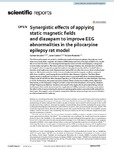Synergistic effects of applying static magnetic fields and diazepam to improve EEG abnormalities in the pilocarpine epilepsy rat model

View/
Use this link to cite
http://hdl.handle.net/2183/32319
Except where otherwise noted, this item's license is described as Creative Commons Attribution 4.0 International Licence (CC-BY 4.0)
Collections
- Investigación (FCS) [1295]
Metadata
Show full item recordTitle
Synergistic effects of applying static magnetic fields and diazepam to improve EEG abnormalities in the pilocarpine epilepsy rat modelDate
2023-01-05Citation
de Labra C, Cudeiro J, Rivadulla C. Synergistic effects of applying static magnetic fields and diazepam to improve EEG abnormalities in the pilocarpine epilepsy rat model. Sci Rep. 2023 Jan 5;13(1):214.
Abstract
[Abstract] The lithium-pilocarpine rat model is a well-known model of temporal epilepsy. Recently we found that transcranial static magnetic stimulation (tSMS) delay and reduce the signs of EEG in this model. We aim to test the effect of combining the therapeutic action of tSMS and diazepam, a drug used to treat status epilepticus. We induce epilepsy in 12 Sprague-Dawley rats. Animals were classified as "magnet" when a magnetic neodymium cylinder was placed over the skull or "control" when a stainless-steel replica was used. Diazepam was injected 60-min after the second doses of pilocarpine injection. We found a reduction in the number of spikes/minute for magnet condition compared with sham condition, reaching significance at 60 min after diazepam injection. The Root-Mean-Square shown a significant reduction in magnet animals compared with those receiving diazepam (Tukey's-test 30 and 60 min after diazepam injection, p < 0.01; 40 and 50 min after diazepam injection, p < 0.05). Furthermore, the power spectrum analysis shown a reduction in delta, theta, alpha and beta bands, on the diazepam + magnet animals compared to the diazepam + sham group. Analysis of high-frequency oscillations revealed an increased in the ripples due to pilocarpine being reduced by diazepam. Our results demonstrate that application of tSMS previously to diazepam potentiates the effect of the drug by reducing the electroencephalographic pattern associated with epileptiform discharges. We suggest a new synergistic cooperation between pharmacology and neuromodulation as a future treatment for epilepsy.
Editor version
Rights
Creative Commons Attribution 4.0 International Licence (CC-BY 4.0)
ISSN
2045-2322






